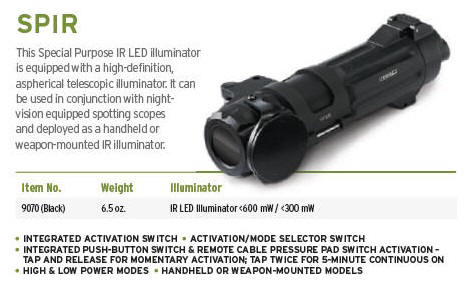



Please Call (702) 324-6463 or email sales@nitevis.com
|
|
|
Categories |
||||||||||||||||||||||||||||||||||||||||||||||||||||||||||||||||||||||||||||||||||||||||||||||||||||||||||||||||||||||||||||||||||||||||||||||||||||||||||||||||||||||||||||||||||||||||||||||||||||||||||||||||||||||||||||||||||||||||||||||||||||||||||||||||||||||
Helpful Info Export Regulations
|
9070 Special Purpose IR Battle Light
Part Number: 9070 (Black)

The Special Purpose IR LED illuminator (SPIR) is equipped with a High-Definition, Aspherical, Telescopic LED illuminator. This eye-safe infrared device outperforms all other tactical IR illumination tools for brightness and range.
Ideal for sniper, designated marksman, over-watch, counter-sniper and free protection operations, the SPIR allows the operator to take advantage of clip-on night vision technology by providing powerful IR illumination to the maximum range of the night vision device.
The SPIR can also be used in conjunction with night vision equipped spotting scopes, making low light and no light surveillance and reconnaissance much more precise and accurate.
The SPIR can be deployed as a handheld or weapon-mounted IR illuminator

![]() Features
Features
| Wavelength | 850 nm |
|---|---|
| FDA Class | Eye-Safe |
| Beam Divergence | 2 - 30 Degrees |
| *Range | 1,000 m |
| Battery | CR 123A (2) |
| Battery Life (mode dependent) | 2 Hours |
| Warranty | 3-Year |
| Material | High-Impact Polymer |
| Color | Black |
| Weight (w/Battery & Mount) | 6.5 oz. |
| Dimensions | 6.75 (L) x 1.55 (D) x 1.95 (H) |
| Temperature Range | -40 to +65 degrees F |
| Waterproof | Submersible to 5 m |
| Mount | MIL-STD-1913/Picatinny rail |
| Activation Switch | Integrated Push Button |
| Remote Cable Pressure Pad | Included |

|
|
||
|
Name:
|
|
SPIR "Special Purpose IR" Battle Light |
|
Ordering Part Number:
|
|
9070 |
|
UPC:
|
|
000381890702 |
|
Mounting Capabilities:
|
|
MIL-STD 1913 Picatinny Rail |
|
Operation:
|
|
Constant-On |
|
IR High/Low Output:
|
|
600mW/300mW |
|
Operational Range (IR):
|
|
1,000 Meters |
| IR Spectrum: |
|
850nm |
| Battery Life: |
|
>2 Hours |
| Housing: |
|
High-Impact, Glass-Filled Polymer |
| Waterproof: |
|
+5 Meters |
| Activation: |
|
Push-button or remote cable pressure pad |
| Weight w/Batteries: |
|
6.5 oz |
| Batteries: |
|
(2) 123A 6-Volt Operation |
| Body Color: |
|
Black |
| LED Color: |
|
IR (Infrared) |
| Fits: |
|
Handguns/Long Guns w/Picatinny or Universal Rails |
|
Warranty:
|
|
3 Year Warranty
|
Home | Contact Us | About KERIF | Export Regulations | How to Order

![]()
(702) 324-6463 / (702) 869-8451 FAX